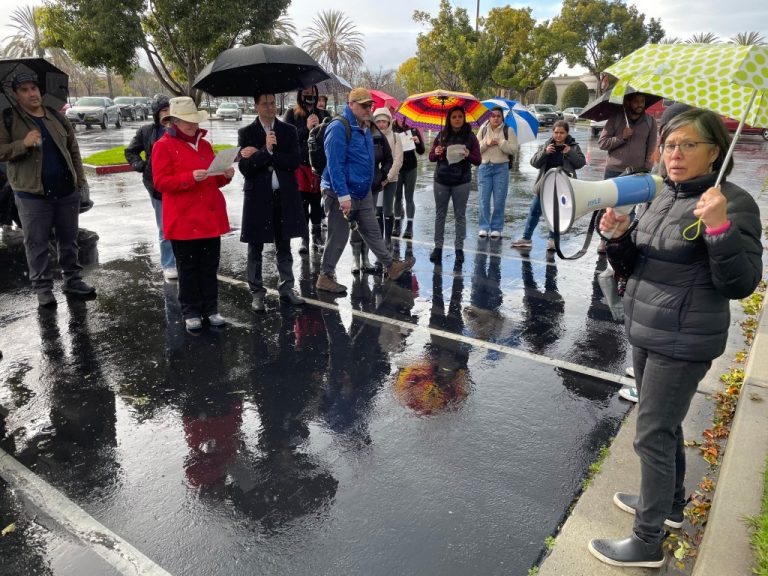With a bullhorn in hand, San Jose Vice Mayor Rosemary Kamei guided a group of urban planning students from San Jose State University to the El Paseo shopping center area in February. Kamei, whose West San Jose council district borders Saratoga, reached out to SJSU to bring in urban planning students to conduct a study on the potential impacts of a proposed Costco near the city’s border. Student interns are also working with the Los Gatos Thrives Foundation, helping shape the vision for a new multigenerational community center in town. (Photo by Rick Koss)
In the West Valley, as plans for a new community center in Los Gatos and a Costco development in West San Jose get underway, local leaders are tapping into a new resource: urban planning students from San Jose State University.
“The program is part of a goal to give students experience that prepares them to make positive changes from the get-go when they graduate,” said Rick Koss, a professor in the Department of Urban and Regional Planning.
“We want students to really advance sound urban planning that prioritizes equity, but we also want them to have marketable skills like GIS, community engagement and report writing, which are all skills that we think urban planners excel at,” Koss said.
Saratoga Vice Mayor Belal Aftab said earlier this year that he worked with students from San Jose State University as part of discussions about a Costco planned to be built near Saratoga’s city limits. The Saratoga City Council voted in February to respond to an environmental impact statement for the project, voicing concerns about the assessment of the project’s impact on the community.
Aftab said San Jose Vice Mayor Rosemary Kamei contacted San Jose State University to invite urban planning students to help study the potential impacts of the proposed Costco. The students have also conducted research on the project and hosted meetings with local leaders from Saratoga and other cities that would be affected by the development to gather input and concerns.
Aftab believes city officials should regularly tap into “the latest thinking from academia.” “What lessons can we learn from other parts of the world, other parts of the state, the Bay Area? What better way to do that than having graduate students studying this all day every day?”
Koss said he became involved through a required graduate research course that encourages students to get out of the classroom and get involved in the community.
“I think the students in my classes know that the work they’re doing is valuable and that it’s something that’s actually going to be reviewed by public officials and experts, and that really helps motivate them to do the highest quality work,” Koss said.
SJSU students have also been part of a recent effort spearheaded by the Los Gatos Thrives Foundation, envisioning what a new multigenerational community center for the town could look like.
At a community meeting the foundation held in June to solicit ideas, SJSU interns helped create a variety of fact sheets about other community centers in the Bay Area for attendees to use in the discussion.
Tom Picklow, president of the foundation, said the interns’ work helps supplement the feedback the foundation has been seeking from local residents with background information on the development of community centers across the country.
Piculow said the foundation does not currently have the funds to pay the interns, but added that the organization hopes the interns will remain involved throughout the community center development process and the foundation will eventually find the funds to pay the interns.
“We’re very happy to have them on board,” Piculow said. “They’re smart, they’re well-spoken, they’ve got good writing skills, they’ve got good organization, they’ve got good ideas, so it’s been a mutually supportive relationship.”


